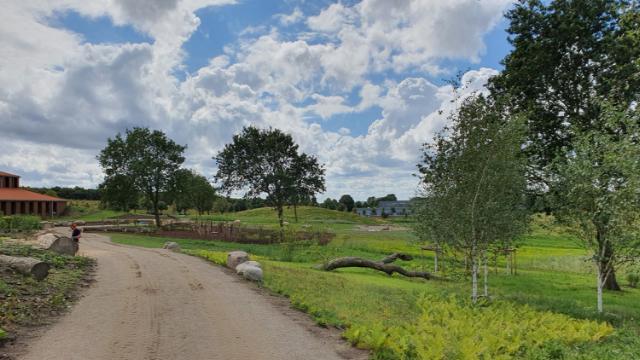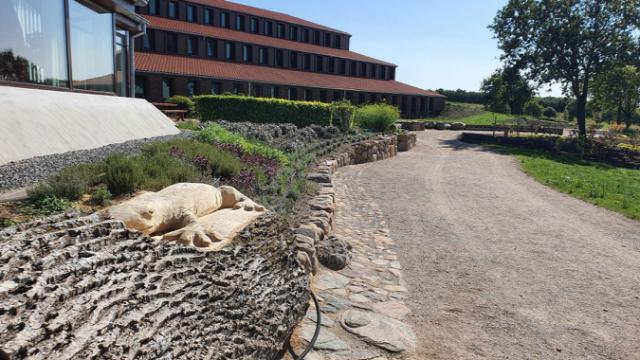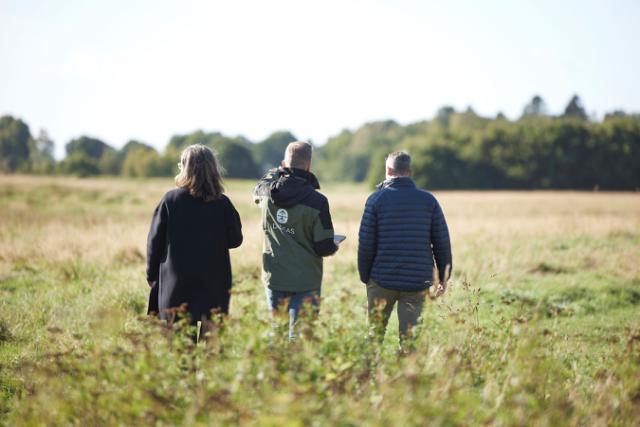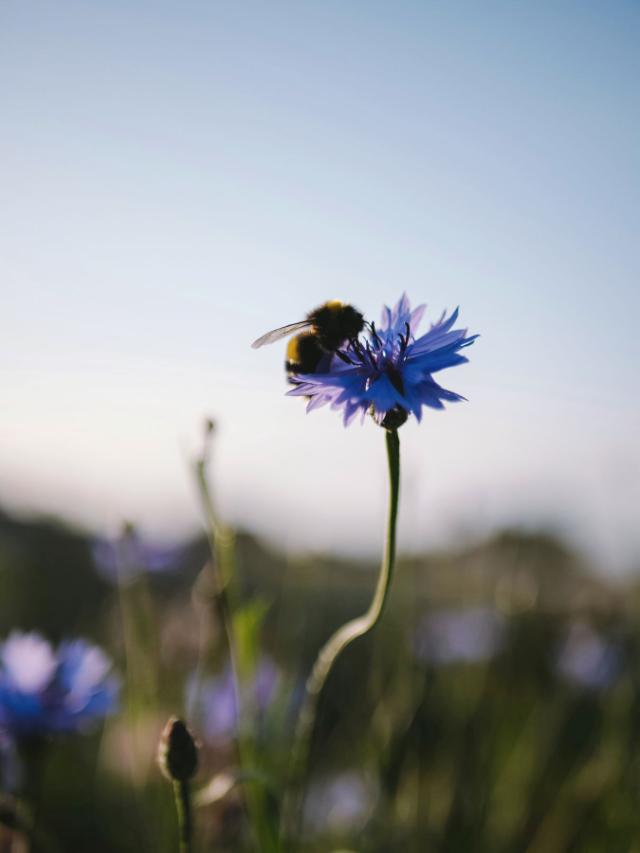Biodiversity Park
Better conditions for biodiversity are the focus of Hedeselskabet’s biodiversity park, which is a vibrant area for animals, plants, and people.
Hedeselskabet’s Biodiversity Park was developed and established by Dalgas and was officially inaugurated on September 10, 2021.

A living experiment
In Hedeselskabet’s biodiversity park, we assist nature and create favorable conditions for the naturally occurring insects, animals, and plants. Through data, observations, and monitoring, we can learn more about nature and use the park as a living laboratory.
The park is also open to the public, allowing us to contribute to the dissemination of knowledge about nature and biodiversity.
Zones of the biodiversity park
In the park, you will find various types of flavourful herbs and fragrant flowers.
Over time, herbs have been used as nature’s medicine cabinet. For example, thyme and sage have antiseptic and expectorant properties. The strong scent of mint can be enjoyed in tea and mint water, but it also affects insects — some, like the cabbage butterfly, tend to avoid it.
This knowledge can be consciously applied when we combine herbs in the kitchen garden while supporting biodiversity.

In summer, the flower meadow appears as a beautiful, vibrant carpet of colours, pleasing to the eye and providing a rich source of nectar for local insects.
The term “flower meadow” encompasses a wide variety, and in this park, we demonstrate different types. We experiment with various soil treatments, such as harrowing and tilling, to investigate the impact of soil structure on plant life. Some plots are left untreated entirely.
Flower meadows encouraged
The picking beds along the sidewalk consist of long-blooming mixtures made up of various wildflowers. These include both annual and perennial species, ensuring blooming in the first year. Different grasses and herbs will also be present.
Flower meadows established from the start
In the beds throughout the park, we use a wide range of flower mixtures, creating a long band of diverse beds. This includes 28 different wild Danish flowers that are well-suited for the specialists among our Danish insects.
Flower fields grown from grass
On the two hills, tall and medium-height grasses grow alongside various herbs. This benefits butterflies, bees, and other insects, which thrive better when the grass has varying lengths.
With its green shades — accented by yellow, pink, and purple — the ground serves as a calm backdrop for the colourful flower mixtures. Over time, perennials and bulbs will spread throughout the bed, and after a few years, the birch trees will grow together into a group.
The park’s flowers provide nectar for wildlife from February (crocus) to October (asters). Both insects and birds find shelter and food in the seeds and bark of oak and birch trees. Seed heads from grasses and perennials also serve as a pantry for birds.
The forest garden has multiple layers of plants: fruit trees, berry bushes, and ground-covering wild strawberries. Here, you will find raspberries and wild strawberries. The berries provide both nourishment and moisture for insects, small animals, and birds, as well as for the kitchen and park guests. Bark mulch, bushes, and ground cover are filled with various forms of micro-life.
In the small forests, there are gray willows with catkins, thirst, and red alder — lilac, dogwood, and blueberries — larch and pine with heather, helmets, and winter rye, along with afforestation seed mixtures as cover crops.
.jpg&width=640&format=webp&quality=75)
Water is one of the cornerstones of life, and recycling valuable resources is a fundamental aspect of our work. Therefore, we utilise our own rainwater in the biodiversity park. The lake attracts both insects and animals that come to quench their thirst and take refuge. The plants have both aesthetic and functional value, helping to absorb rainwater.
The lake functions as a flow-through basin, filled most of the year. It has an outlet to the south and an emergency overflow in the well. The outlet and overflow lead to the rainwater sewer. A pump in the well pumps water into the stream.
Facts about the rainwater lake:
- The lake is filled with rainwater from our roof, which has an area of approximately 2,300 m², along with our pavement of about 700 m² totaling 3,000 m².
- Annually, approximately 2,300 m³ (2.3 million litres) of rainwater is directed into the lake. The lake holds 42 m³ (42,000 litres). It has a surface area of 156 m², and the water depth is 90 cm.
- The bottom of the lake and the associated stream are lined with a 50 cm thick layer of blue clay, ensuring that the water does not seep directly into the ground.
Dead wood provides shelter, food for insects, and space for fungi and mosses. Stones collect heat and provide shelter for small animals like lizards and hedgehogs, which use the stones as hiding places and nesting boxes.
Our raft hotel and brushwood fences, cut tree trunks, and stone arrangements help create conditions for a rich diversity of nature — while also providing park visitors with exciting experiences.
.jpg&width=640&format=webp&quality=75)
Scent and taste
In the park, you will find various types of flavourful herbs and fragrant flowers.
Over time, herbs have been used as nature’s medicine cabinet. For example, thyme and sage have antiseptic and expectorant properties. The strong scent of mint can be enjoyed in tea and mint water, but it also affects insects — some, like the cabbage butterfly, tend to avoid it.
This knowledge can be consciously applied when we combine herbs in the kitchen garden while supporting biodiversity.

The flower treasure
In summer, the flower meadow appears as a beautiful, vibrant carpet of colours, pleasing to the eye and providing a rich source of nectar for local insects.
The term “flower meadow” encompasses a wide variety, and in this park, we demonstrate different types. We experiment with various soil treatments, such as harrowing and tilling, to investigate the impact of soil structure on plant life. Some plots are left untreated entirely.
Flower meadows encouraged
The picking beds along the sidewalk consist of long-blooming mixtures made up of various wildflowers. These include both annual and perennial species, ensuring blooming in the first year. Different grasses and herbs will also be present.
Flower meadows established from the start
In the beds throughout the park, we use a wide range of flower mixtures, creating a long band of diverse beds. This includes 28 different wild Danish flowers that are well-suited for the specialists among our Danish insects.
Flower fields grown from grass
On the two hills, tall and medium-height grasses grow alongside various herbs. This benefits butterflies, bees, and other insects, which thrive better when the grass has varying lengths.
Plantings
With its green shades — accented by yellow, pink, and purple — the ground serves as a calm backdrop for the colourful flower mixtures. Over time, perennials and bulbs will spread throughout the bed, and after a few years, the birch trees will grow together into a group.
The park’s flowers provide nectar for wildlife from February (crocus) to October (asters). Both insects and birds find shelter and food in the seeds and bark of oak and birch trees. Seed heads from grasses and perennials also serve as a pantry for birds.
The forest garden has multiple layers of plants: fruit trees, berry bushes, and ground-covering wild strawberries. Here, you will find raspberries and wild strawberries. The berries provide both nourishment and moisture for insects, small animals, and birds, as well as for the kitchen and park guests. Bark mulch, bushes, and ground cover are filled with various forms of micro-life.
In the small forests, there are gray willows with catkins, thirst, and red alder — lilac, dogwood, and blueberries — larch and pine with heather, helmets, and winter rye, along with afforestation seed mixtures as cover crops.
.jpg&width=640&format=webp&quality=75)
Rainwater
Water is one of the cornerstones of life, and recycling valuable resources is a fundamental aspect of our work. Therefore, we utilise our own rainwater in the biodiversity park. The lake attracts both insects and animals that come to quench their thirst and take refuge. The plants have both aesthetic and functional value, helping to absorb rainwater.
The lake functions as a flow-through basin, filled most of the year. It has an outlet to the south and an emergency overflow in the well. The outlet and overflow lead to the rainwater sewer. A pump in the well pumps water into the stream.
Facts about the rainwater lake:
- The lake is filled with rainwater from our roof, which has an area of approximately 2,300 m², along with our pavement of about 700 m² totaling 3,000 m².
- Annually, approximately 2,300 m³ (2.3 million litres) of rainwater is directed into the lake. The lake holds 42 m³ (42,000 litres). It has a surface area of 156 m², and the water depth is 90 cm.
- The bottom of the lake and the associated stream are lined with a 50 cm thick layer of blue clay, ensuring that the water does not seep directly into the ground.
Dead wood and stones
Dead wood provides shelter, food for insects, and space for fungi and mosses. Stones collect heat and provide shelter for small animals like lizards and hedgehogs, which use the stones as hiding places and nesting boxes.
Our raft hotel and brushwood fences, cut tree trunks, and stone arrangements help create conditions for a rich diversity of nature — while also providing park visitors with exciting experiences.
.jpg&width=640&format=webp&quality=75)

Data from nature
Our sensors in the biodiversity park provide digital data from nature that we can use in our daily work.
With the help of a moisture meter, we only water when necessary. This way, we conserve water as a resource — while also ensuring that growth is not harmed by overwatering or underwatering.
.jpg&width=640&format=webp&quality=75)
Space for visitors in the park
Along the paths, there are resting and meeting places available for park guests and our employees.
People counters tell us when and how the park is used, allowing us to better plan maintenance and care. A smoothness station measures humidity, air temperature, and road temperature, so we can implement winter services in the parking lot.
In this way, we also use data to create access to the park for those who need fresh air, wind in their hair, and the sound of rustling leaves in their ears.
A new expression from year to year
Through data and professional development, we continuously learn more about the plants and the insect and animal species that inhabit or visit the biodiversity park. Therefore, the park is in constant development and changes its appearance from season to season — and from year to year.
How we work with nature-based solutions
End-to-end solutions for your ESG strategy
Our nature-based solutions restore ecosystems and promote sustainability through innovative actions. We develop tailored projects that benefit the environment and contribute to your company’s ESG strategy.
With a complete service – from advice to implementation and monitoring – we ensure that the projects are based on the latest knowledge and best practices. We help realise ambitious ecosystem restoration projects, ensure compliance, and create visible results that strengthen your ESG profile and brand.
How we work with biodiversity
A digital and data-driven approach
At Dalgas, we create habitats where different species can thrive and contribute to a healthy and robust ecosystem. A diverse ecosystem that promotes both nature’s and people’s well-being.
We combine data, scientific knowledge, and practical experience to ensure that your biodiversity project has a positive and lasting impact on nature. Therefore, documentation and monitoring are central elements in our work. And you can use the data in your ESG reporting.
Hedeselskabet – partnering with nature
Dalgas is part of Hedeselskabet – founded in 1866 and still growing. Hedeselskabet is an association of people working for a sustainable future. And who have the necessary knowledge and experience to lead the way.
Hedeselskabet supports
Working for a sustainable future requires resources. Hedeselskabet participates in the development of nature and the environment, and we take responsibility. Therefore, we allocate funds to relevant development projects and member-driven projects, as well as award scholarships. For the benefit of all of us – now and in the future.

We create value for your industry
Dalgas solves all types of green tasks in a range of different industries and sectors across services. We have the experience, machinery, and references that ensure you the best possible solution.



